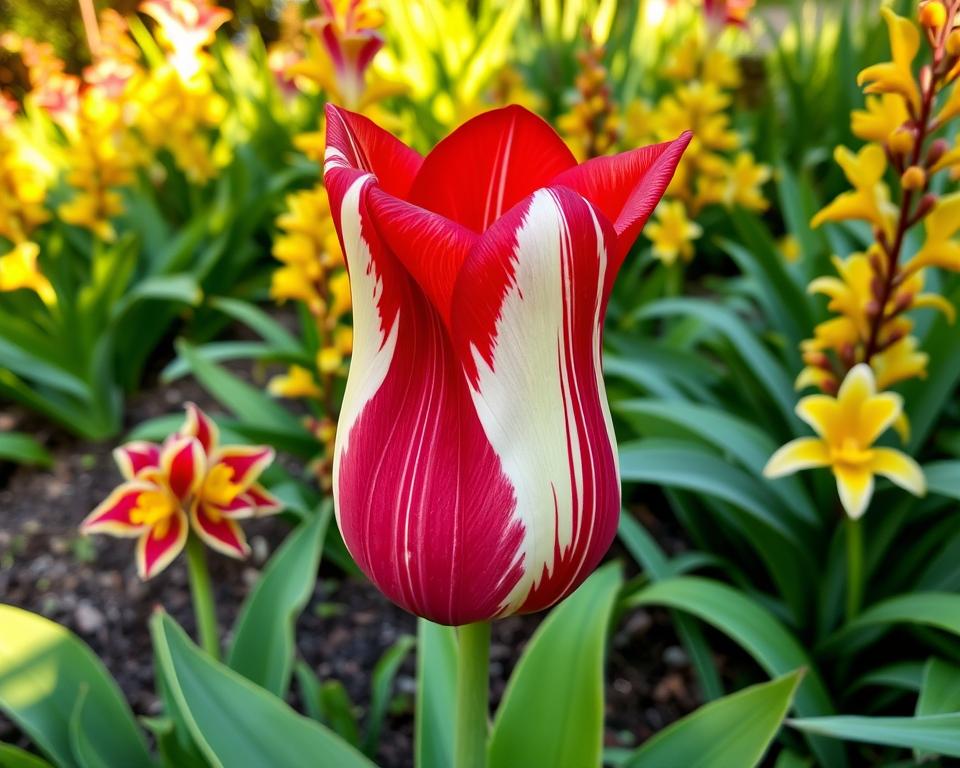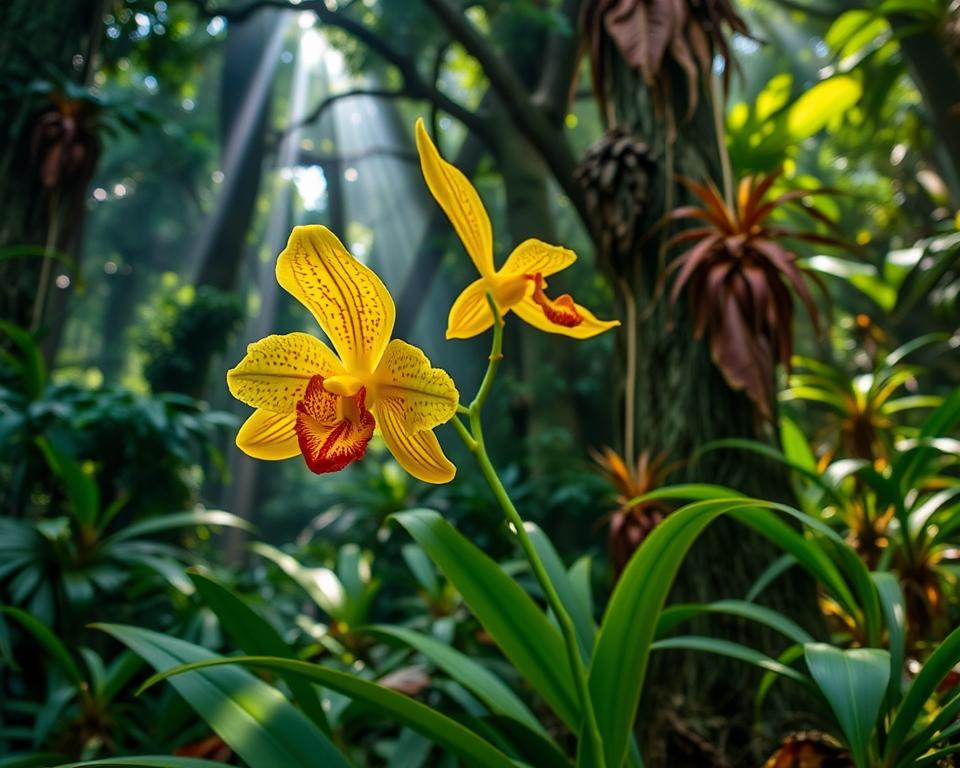Low-Maintenance Flowers: Ideal Species for Those with Little Time
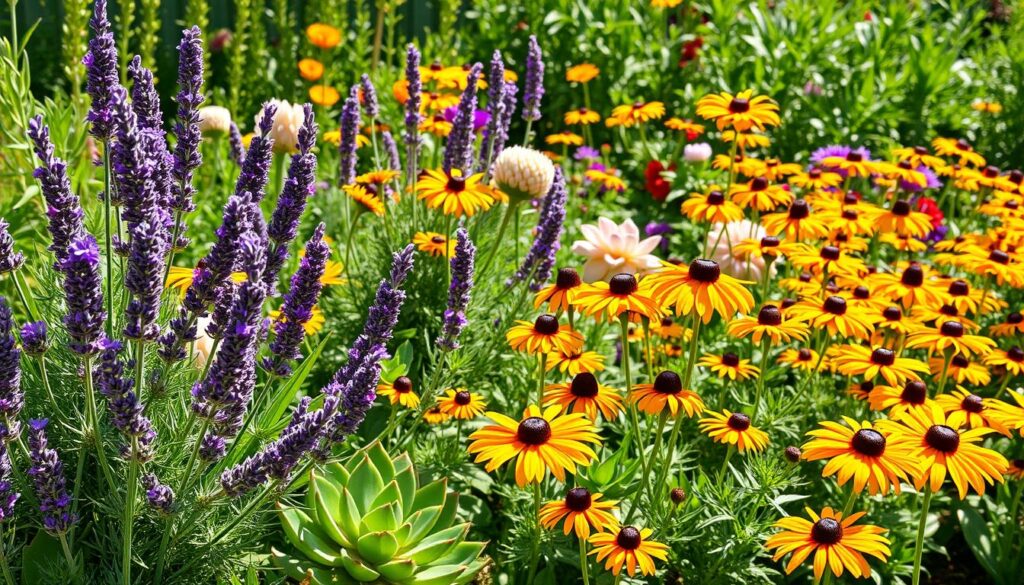
Busy gardeners often struggle to find time for their gardens. Low-maintenance flowers are a great solution. They are perfect for those who want to enjoy nature’s beauty without constant upkeep.
More people are choosing low-maintenance flowers to make gardening easier. These flowers are not only beautiful but also simple to care for. They allow anyone to have a stunning garden without spending hours each day.
Low-maintenance flowers are ideal for adding color and beauty to outdoor spaces. They are perfect for busy gardeners who want to enjoy gardening without spending too much time.
With their ease of care and beautiful blooms, they are a great choice for simplifying gardening.
The Benefits of Low-Maintenance Flowers
Low maintenance gardening is great for those who love flowers but don’t have a lot of time. It’s perfect for beginners who find gardening too overwhelming. With the right flowers, anyone can have a beautiful garden without spending too much time on it.
One big plus of low-maintenance flowers is they save time. They need less watering, pruning, and fertilizing.
This makes them ideal for people who are always busy. Succulents and perennials are great examples because they need very little care.
Cost-Effective Choices
Low-maintenance flowers also save money. They don’t require expensive tools or frequent watering and fertilizing. This makes them a smart choice for those watching their budget.
Enhanced Aesthetics with Minimal Effort
These flowers can also make a garden look amazing with little effort. They come in many colors and shapes. With the right flowers, anyone can create a beautiful garden that’s easy to maintain.
- Succulents
- Perennials
- Wildflowers
These flowers are perfect for those who want to garden with minimal effort. They need less care than other flowers.
Choosing the Right Location for Low-Maintenance Flowers
Choosing the right spot for low-maintenance flowers is key for their health. Knowing about soil types and sunlight is important. Simple flower care tips help your plants grow well with little effort.
First, think about how much sunlight your flowers need. Most need 4-6 hours of direct sunlight daily. Also, the quality of your soil and how well it drains is crucial. The right soil types help your plants absorb water and nutrients better.
Here are some key factors to consider when selecting a location for your low-maintenance flowers:
- Sunlight requirements: 4-6 hours of direct sunlight per day
- Soil types: choose soil that drains well and is rich in nutrients
- Drainage considerations: ensure the soil is not waterlogged, which can lead to root rot
By considering these factors and following basicflower care tips, you can have a beautiful garden with little upkeep. Make sure to pick the rightsoil types and follow gardening basics for your low-maintenance flowers.
| Soil Type | Characteristics | Suitable for |
|---|---|---|
| Clay soil | Heavy, dense, and prone to waterlogging | Plants that thrive in moist conditions |
| Sandy soil | Light, well-draining, and prone to drying out | Plants that prefer dry conditions |
| Loamy soil | Balance of clay, silt, and sand, well-draining and fertile | Most low-maintenance flowers |
Top Low-Maintenance Flower Species
Looking to beautify your garden without the fuss? There are many easy care flowers that fit the bill. Lavender, coneflower, and sedum are perfect for those with little time to garden.
These plants are stunning, tough, and can grow well in many conditions, making them great for succulent gardens.
These plants stand out because they can handle drought, need little pruning, and draw in pollinators. They also rarely get pests or diseases, which is a plus for those who don’t like using chemicals. Here are some low-maintenance flower species:
- Lavender: A fragrant, purple flower that is perfect for attracting pollinators and adding a touch of elegance to any garden.
- Coneflower: A resilient and beautiful flower that comes in a variety of colors, including pink, purple, and white.
- Sedum: A succulent plant that is perfect for hot, dry areas and comes in a variety of shapes and sizes.
These plants are ideal for those who want to enhance their gardens without spending a lot or a lot of time. By choosing easy care flowers and low maintenance plants, gardeners can enjoy the perks of succulent gardening without the stress.
With a bit of planning and research, anyone can have a stunning garden using low-maintenance flower species. Whether you’re an experienced gardener or just starting, these plants are a fantastic choice for adding beauty to your outdoor space.
Seasonal Considerations for Flower Planting
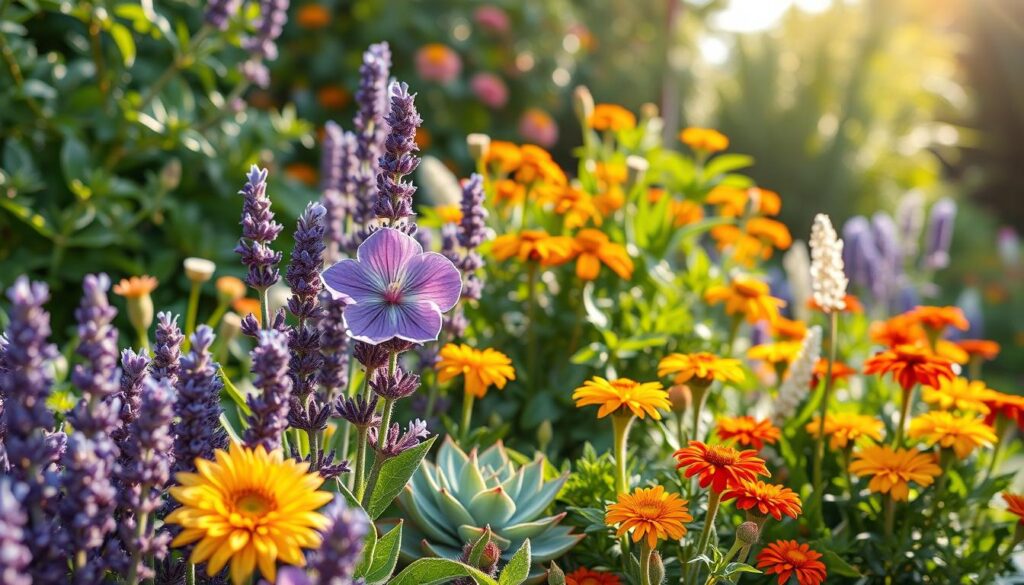
As the seasons change, it’s key to know the best times to plant and care for flowers. A good seasonal gardening plan can make your garden beautiful all year with little effort. When making a flower planting guide, think about what each plant needs in different seasons.
In spring, plant cool-weather flowers like tulips and daffodils. For summer, choose heat-tolerant flowers like black-eyed susans and coneflowers.
In fall, plant asters and sedum for color in cooler weather. And in winter, focus on winter garden care to protect plants from cold and keep them moist.
Some important seasonal gardening tips are:
- Plant flowers in the right season for best growth and blooms
- Give plants the right care, like watering and fertilizing, in each season
- Keep plants safe from extreme weather, like frost and heatwaves
By using these tips and making a detailed flower planting guide, you can have a stunning, easy-to-care-for garden all year. And don’t forget to take good care of your garden in winter to help your plants survive the cold.
Maintaining Your Low-Maintenance Flowers
Low-maintenance flowers are easy to care for. But, they still need some attention to stay healthy. By following a few simple tips, you can keep your flowers looking great. Watering is key, but don’t overdo it. Too much water can harm your flowers.
Here are some tips for watering your low-maintenance flowers:
- Water them in the morning to allow the plants to absorb the water throughout the day
- Check the soil moisture by sticking your finger into the soil up to the first knuckle
- Water only when the soil feels dry to the touch
Pruning and Deadheading Techniques
Pruning and deadheading are crucial for your flowers’ health and look. Removing dead flowers encourages new growth. It also stops diseases from spreading. Regular pruning keeps your plants in shape and size.
By following these simple tips, your low-maintenance flowers will thrive. Don’t forget to fertilize them regularly. Prune them as needed to keep them looking their best.
Popular Perennials That Require Minimal Care
Perennial flowers are perfect for those who want to beautify their gardens with little effort. Plants like daylilies, black-eyed Susans, and catmint are ideal for busy gardeners. They can grow well in many conditions and need very little care.
Some popular perennial flowers include:
- Daylilies: known for their vibrant color and ability to bloom all year
- Black-eyed Susans: easy to grow and hardy, with bright yellow petals and dark centers
- Catmint: low-maintenance and attractive, with gray-green leaves and purple flowers
These flowers are not just beautiful; they’re also easy to take care of. They can handle some neglect and still do well. This makes them great for gardens that need little upkeep. With the right care, these plants can bring joy and beauty to your garden for years.
Choosing the right perennial flowers can help you create a stunning, easy-to-maintain garden. With a bit of planning and creativity, anyone can enjoy the beauty of these flowers without spending too much time on upkeep.
The Role of Native Plants in Low-Maintenance Gardens
Native plants are perfect for gardens that don’t need much care. They are strong against pests and diseases. This is great for people who don’t have a lot of time to garden.
By using native plants, you help local wildlife and create a healthy garden. It’s a win-win for both you and nature.
Benefits of Native Species
Native plants are good for bees and butterflies. They also handle bad weather well. Plus, they need less water and food, saving you time and money.
- Low water requirements
- Resistance to pests and diseases
- Attract local pollinators
- Support biodiversity
Recommended Native Flower Options
For a beautiful garden, try coneflower, black-eyed susan, and sedum. They look great and need little care.
Incorporating Low-Maintenance Flowers into Landscaping
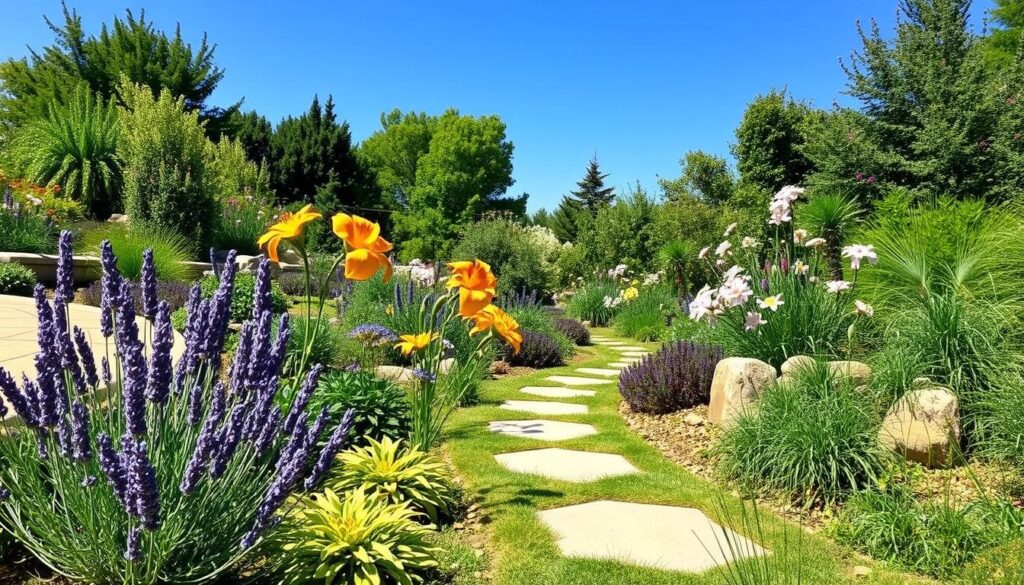
Creating a beautiful garden is easier with low maintenance landscaping. By using low-maintenance flowers, you can enjoy a lovely outdoor space with little upkeep. Companion planting is a great way to pair flowers with other plants for better growth and care.
A good garden design considers each plant’s needs, like sunlight and soil. Choose flowers that do well in your area to make a stunning, easy-to-care-for garden. Flowers like coneflowers, black-eyed susans, and sedum are great for this.
- Choose flowers that bloom at different times for a changing display
- Make sure each plant has enough space to grow
- Use a mix of annuals and perennials for depth and interest
By using these tips and adding low-maintenance flowers, you can have a beautiful garden that’s easy to care for.
| Flower | Maintenance Needs | Companion Planting Options |
|---|---|---|
| Coneflower | Low watering needs, full sun | Black-eyed susans, sedum |
| Black-eyed Susan | Medium watering needs, partial shade | Coneflower, daylily |
| Sedum | Low watering needs, full sun | Coneflower, succulents |
Flowering Shrubs for Minimal Maintenance
Flowering shrubs add beauty and structure to any garden with little effort. They are ideal for those who are busy but still want to enjoy nature. These shrubs also attract bees and butterflies, making them great for pollinators.
Hydrangeas and Spirea are popular choices because they bloom beautifully with minimal care. Butterfly Bush is another favorite, as it draws in many different wildlife species. These shrubs are not only lovely but also simple to maintain, perfect for a low-care garden.
Here are some benefits of flowering shrubs:
- They provide structure and color to the garden
- They are low maintenance and easy to care for
- They are pollinator friendly plants, attracting bees and butterflies
Flowering shrubs are a smart pick for anyone looking to beautify their garden with minimal effort. By selecting low maintenance and pollinator friendly plants, gardeners can create a lively and easy-to-maintain garden.
Tips for Long-Lasting Blooms
To get long lasting blooms, your flowers need the right care. This means watering them often, feeding them, and trimming them.
By doing these things, your flowers will grow strong and look great. For example, deadheading helps flowers bloom more and stops them from making seeds.
Seasonal clean-up is also key for healthy flowers. Get rid of dead leaves and stems to stop diseases and pests. Using natural pest control, like beneficial insects or neem oil, is good for the environment and your flowers.
Here are some important tips for long lasting blooms:
- Give them enough sunlight and water.
- Feed them regularly with a balanced fertilizer.
- Prune and deadhead to encourage new growth.
- Use natural pest control to keep pests away.
By following these tips and using natural pest control, you can have blooms that last a long time. Your garden will be beautiful and full of life. Always take care of your flowers, and they will give you beautiful colors and sweet smells.
The Environmental Impact of Low-Maintenance Flowers
Low-maintenance flowers are perfect for busy gardeners. They also help the environment. These flowers need less water and care, which saves water. This is crucial in areas where water is scarce.
These flowers also help local pollinators. They are full of nectar and pollen, which bees and butterflies love. This supports healthy ecosystems and the local food chain. By planting these flowers, gardeners help the environment and their community.
Some key benefits of low-maintenance flowers include:
- Reduced chemical use: They need fewer pesticides and fertilizers, which cuts down on environmental chemicals.
- Improved soil health: Their deep roots make the soil better, reducing the need for synthetic fertilizers.
- Increased biodiversity: Planting different low-maintenance flowers creates a diverse ecosystem that supports many species.
Low-maintenance flowers are a smart choice for gardeners who care about the environment. They allow gardeners to enjoy gardening while reducing their environmental impact. This makes gardening more sustainable for both the environment and the community.
Resources for Selecting Low-Maintenance Flowers
Starting a beautiful, low-maintenance garden is exciting. There are many resources to help you. Local gardening centers and nurseries have experts who can guide you. They know which flowers are best for your area.
Online flower databases are also great. They let you compare different flowers. This way, you can pick the perfect ones for your garden.
Joining local community gardening workshops is a good idea too. You’ll learn from experienced gardeners. These groups share tips and make gardening more fun.
Using these resources will help you choose the right flowers. You’ll create a beautiful garden that’s easy to care for. With the right knowledge, your garden will thrive with little effort.
Recommended content: Fern plant.
